
"The Ballad of the Green Berets" is a patriotic song in the ballad style about the United States Army Special Forces. It is one of the few popular songs of the Vietnam War years to cast the military in a positive light and in 1966 became a major hit, reaching No. 1 for five weeks on the Hot 100 and four weeks on Cashbox. It was also a crossover hit, reaching No. 1 on Billboard's Easy Listening chart and No. 2 on Billboard's Country survey. Billboard ranked it No. 10 in its year-end chart for 1966, while it tied for first with "California Dreamin'" by the Mamas and the Papas in Cash Box's year-end rankings.
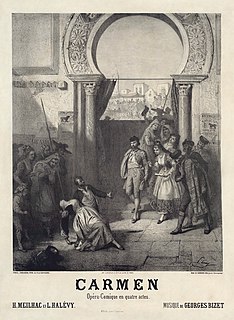
Carmen is an opera in four acts by the French composer Georges Bizet. The libretto was written by Henri Meilhac and Ludovic Halévy, based on the novella of the same title by Prosper Mérimée. The opera was first performed by the Opéra-Comique in Paris on 3 March 1875, where its breaking of conventions shocked and scandalised its first audiences.
A mezzo-soprano or mezzo (; Italian: [ˌmɛddzosoˈpraːno]; meaning "half soprano") is a type of classical female singing voice whose vocal range lies between the soprano and the contralto voice types. The mezzo-soprano's vocal range usually extends from the A below middle C to the A two octaves above (i.e. A3–A5 in scientific pitch notation, where middle C = C4; 220–880 Hz). In the lower and upper extremes, some mezzo-sopranos may extend down to the F below middle C (F3, 175 Hz) and as high as "high C" (C6, 1047 Hz). The mezzo-soprano voice type is generally divided into the coloratura, lyric, and dramatic mezzo-soprano.
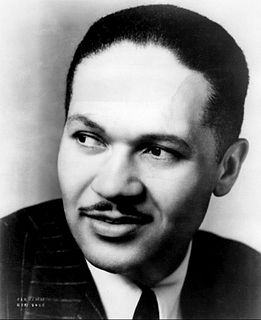
Robert Todd Duncan was an American baritone opera singer and actor. One of the first African-Americans to sing with a major opera company, Duncan is also noted for appearing as Porgy in the premier production of Porgy and Bess (1935).

The 93rd Infantry Division was a "colored" segregated unit of the United States Army in World War I and World War II. However, in World War I only its four infantry regiments, two brigade headquarters, and a provisional division headquarters were organized, and the divisional and brigade headquarters were demobilized in May 1918. Its regiments fought primarily under French command in that war. During tough combat in France, they soon acquired from the French the nickname Blue Helmets, as these units were issued blue French Adrian helmets. This referred to the service of several of its units with the French Army during the Second Battle of the Marne. Consequently, its shoulder patch became a blue French helmet, to commemorate its service with the French Army during the German spring offensive.
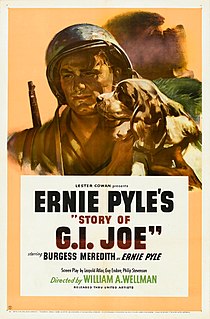
The Story of G.I. Joe, also credited in prints as Ernie Pyle's Story of G.I. Joe, is a 1945 American war film directed by William A. Wellman, starring Burgess Meredith and Robert Mitchum. The film was nominated for four Academy Awards, including Mitchum's only nomination for Best Supporting Actor. This was the film that established him as one of the world's biggest movie stars.
Habanera is the popular name for "L'amour est un oiseau rebelle", an aria from Georges Bizet's 1875 opéra comique Carmen. It is the entrance aria of the title character, a mezzo-soprano role, in scene 5 of the first act.

John Francis Regis Toomey was an American film and television actor.

Yank, the Army Weekly was a weekly magazine published by the United States military during World War II.

At War with the Army is a 1950 American musical comedy film directed by Hal Walker and starring the comedy team of Martin and Lewis and introducing Polly Bergen. Filmed from July through August 1949, the film premiered in San Francisco on New Year's Eve 1950 and was released nationally in the United States on January 17, 1951, by Paramount. It was re-released in 1958 by OMAT Pictures.

The Red Hussar is a comedy opera in three acts by Edward Solomon, with a libretto by Henry Pottinger Stephens, concerning a young ballad singer who disguises herself as a Hussar to follow her penniless beloved to France. By a feat of gallantry, she saves his life and is promoted to the rank of sergeant. It turns out that she is a rich heiress, and all ends happily.

Carmen Jones is a 1954 American musical film featuring an all-black cast starring Dorothy Dandridge, Pearl Bailey and Harry Belafonte, produced and directed by Otto Preminger. The screenplay by Harry Kleiner is based on the lyrics and book by Oscar Hammerstein II, from the 1943 stage musical of the same name, set to the music of Georges Bizet's 1875 opera Carmen. The opera was an adaptation of the 1845 Prosper Mérimée novella Carmen by Henri Meilhac and Ludovic Halévy.
Screaming Eagles is a 1956 black-and-white World War II film directed by Charles F. Haas, released by Allied Artists, and starring Tom Tryon, Jan Merlin and, in her film debut, French Miss Universe 1954 runner-up Jacqueline Beer.

Something for the Boys is a 1944 musical comedy film directed by Lewis Seiler. It stars Carmen Miranda, with Michael O'Shea, Vivian Blaine, Phil Silvers, Sheila Ryan and Perry Como.

The Carmen Suites are two suites of orchestral music drawn from the music of Georges Bizet's 1875 opera Carmen and compiled posthumously by his friend Ernest Guiraud. They adhere very closely to Bizet's orchestration. However the order of the musical allusions are in reversed chronological order, and do not adhere to the operatic versions entirely, although the Suite is directly inspired by Bizet's opera.
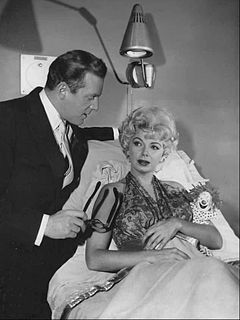
Fredd Wayne was an American actor with a career spanning seven decades on Broadway, radio, television, movies, and recorded works. He appeared on television as a guest star, and portrayed Benjamin Franklin, originally in his one-man show Benjamin Franklin, Citizen, on television, recordings, and live appearances.
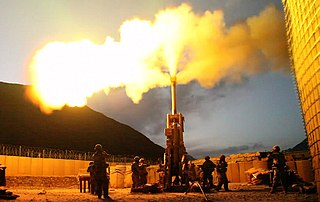
Forward Operating Base Bostick, previously called FOB Naray, was a U.S. military outpost in the Kunar Province of Afghanistan. In July 2008, the name of the base was changed in memory of Major Thomas G. Bostick Jr. of Llano, Texas, who was killed in action.
The 1916 Birthday Honours were appointments by King George V to various orders and honours to reward and highlight good works by citizens of the British Empire. The appointments were made to celebrate the official birthday of The King, and were published in The London Gazette and in The Times on 3 June 1916.
The 253rd Infantry Division was an infantry division of the German Heer during World War II.

This Is The Army is an American musical revue in two acts, designed to boost morale in the U.S. during World War II, with a book by James McColl and music and lyrics by Irving Berlin. It was produced by the U.S. army on Broadway in 1942, with a cast of U.S. soldiers, for the benefit of the Army Emergency Relief Fund.




















